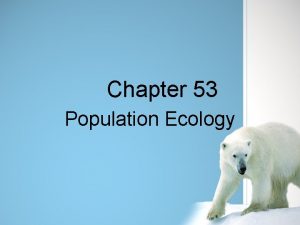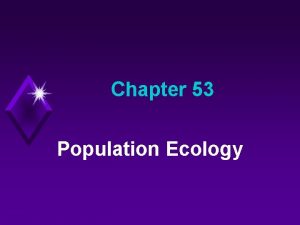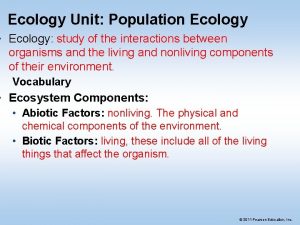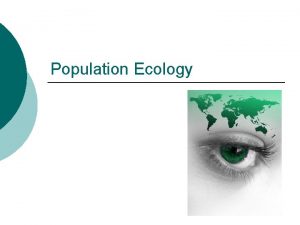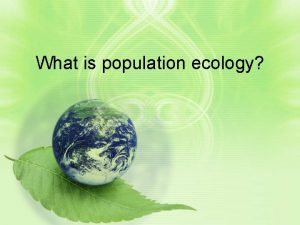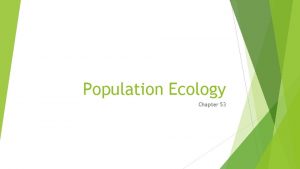Chapter 53 Population Ecology Population Ecology The study











- Slides: 11

• Chapter 53 – Population Ecology

Population Ecology • The study of populations in relation to the environment, including environmental influences on population density and distribution, age structure, and variations in population size – Population – a group of individuals of a single species living in the same general area

Density • Number of individuals per unit area or volume • Affected by immigration, emigration, natality, and mortality • Measure by markrecapture methods

THINK TANK TIME! A B C • Describe three population dispersion patterns shown above. – What would lead to patterns like this in nature?

Dispersion • The pattern of spacing among individuals within the boundaries of the population • Clumped – aggregated in patches • Uniform – evenly spaced • Random – patternless

THINK TANK TIME! A B C • Compare and contrast these 3 survivorship curves. – What reproductive strategies do you think are being used by the organisms represented in each?

Demography • The study of the vital statistics of populations and how they change over time (particularly birth and death rates). • Survivorship curve – a plot of the numbers in a cohort (group of same age) still alive at each age • 3 basic types of curves: I, II, and III, but there are variations to each (ex. crabs)

Population Life History “Strategies” r-selected (opportunistic) • Density independent k-selected (equilibrial) • Density dependent – Birth rate/death rate does NOT change with population density • • Maximizes r (rate of increase) Short maturation and life span Many small offspring Usually only 1 or 2 reproductions early in life • No parental care • High death rate – Death rate rises with population density • • Maximizes population size Long maturation and life span Few large offspring Usually several reproductions later in life • Extensive parental care • Low death rate

Population Growth Models • Change in population size: d. N/dt = r. N – N = population size – t = time – r = per capita birth rate (b) – per capita death rate (m) • Exponential model – idealized, unlimited environment: d. N/dt = rmax. N • Logistic growth model – includes carrying capacity (K), the maximum population size that a particular environment can support: d. N/dt = rmax. N((K-N)/K)

THINK TANK TIME! • Analyze the graph below and describe the relationship between the snowshoe hare population and the lynx. – How can this be explained?

Limiting Factors • Density independent factors – weather, climate, disturbances • Density dependent factors – competition, predation, stress, habitat, territoriality, crowding, health, disease, and waste accumulation
 Chapter test a chapter 4 population ecology answer key
Chapter test a chapter 4 population ecology answer key Study guide chapter 4 section 1 population dynamics
Study guide chapter 4 section 1 population dynamics Section 1 population dynamics
Section 1 population dynamics Population ecology section 1 population dynamics
Population ecology section 1 population dynamics Chapter 53 population ecology
Chapter 53 population ecology Chapter 36 population ecology
Chapter 36 population ecology Chapter 4 population ecology answer key
Chapter 4 population ecology answer key Chapter 53 population ecology
Chapter 53 population ecology Chapter 4 section 1 population dynamics
Chapter 4 section 1 population dynamics Chapter 53 population ecology
Chapter 53 population ecology Chapter 3, section 1: community ecology answer key
Chapter 3, section 1: community ecology answer key Clumped dispersion
Clumped dispersion













